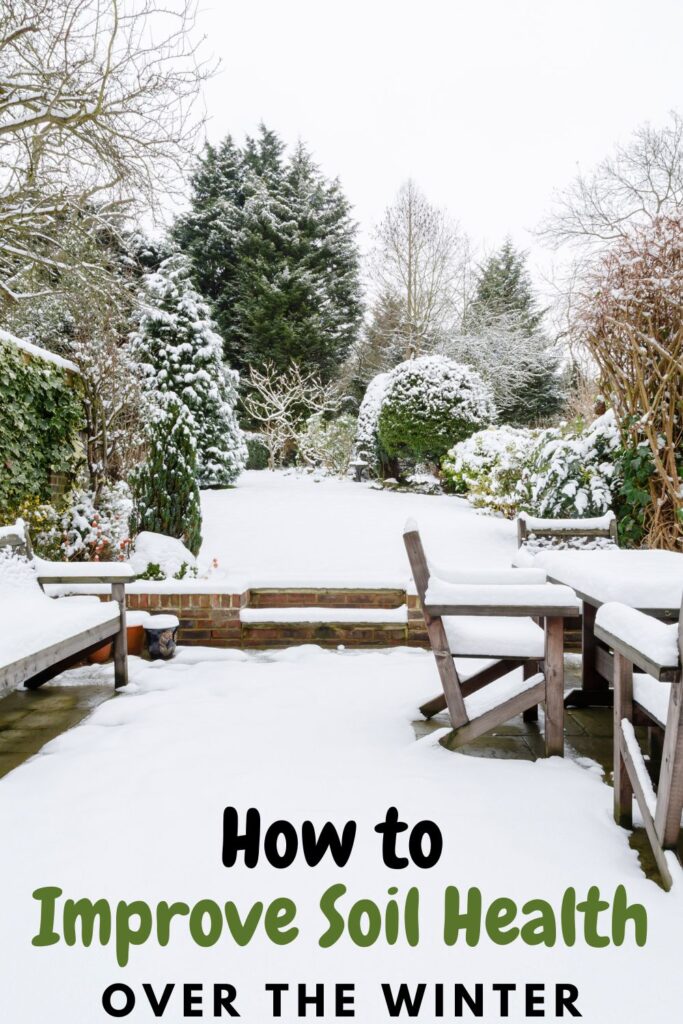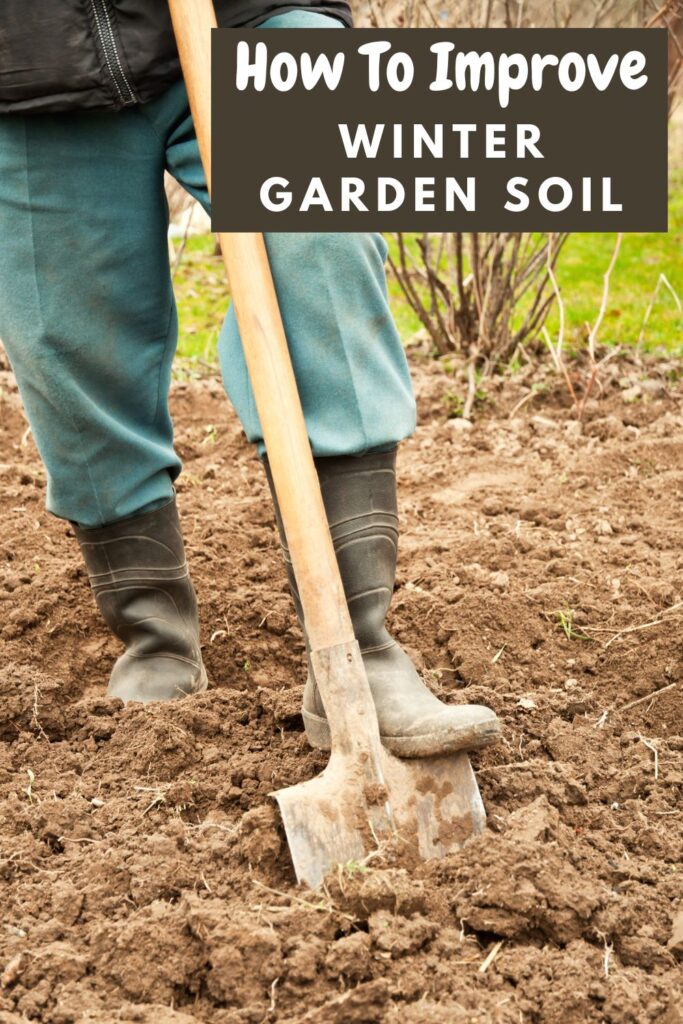As the days grow shorter and the weather starts to cool, many gardeners are already thinking about next spring’s planting. But a good crop next spring requires that you learn how to improve soil health over the winter. By taking a few simple steps over the winter months, you can help your garden soil stay healthy and fertile for planting new flowers and vegetables next spring.
From no til gardening and fall garden amendments to cover cropping and soil pH, there are a lot of factors that impact garden soil health as soil temperatures drop. Keep reading for some tips on improving garden soil for an abundant growing season next spring. Since I have clay soil here in Georgia, this is an ongoing battle for me!
Posts feature partner companies & may be sponsored. Post contains affiliate links & I will be compensated if you make a purchase after clicking on links. As an Amazon Associate I earn from qualifying purchases.
Table of Contents
Wait to Cultivate
After all the warm sun and daily garden watering have passed, the fall garden is alive with fungi. And those fungi have microscopic threads spread all through your soil. That’s a good thing!
The fungi will continue breaking down organic material, roots, and other soil bits all winter long. Unless you till up that soil and destroy all of its hard work.
If you want to plant an early spring garden, you might need to do a small amount of tilling. However, adding fall soil amendments to the TOP of your garden will be more beneficial in the long run than deep tilling. Leave the soil surface where it is to protect the soil life that lives underneath it.
✯Don’t want to miss the next post?✯ Follow Turning the Clock Back on Facebook | Twitter | Pinterest Or join the private Facebook group for simple tips on going green!
Build Better Soil
Organic matter such as compost or manure will help build soil structure, making it more loose and able to hold moisture and nutrients. There are many different types of soil amendments you can choose from and knowing how to apply them is important.
Types of organic matter
One of the best ways to improve garden soil is to add organic matter. This can be done in the fall, before planting, to give it time to break down and improve the quality of the soil.
Organic soil amendments can include leaves, compost, and manure, as well as a few other materials. Each has its own benefits and should be chosen based on the specific needs of the garden.
For example, leaves are a good source of carbon and help improve soil structure. Compost is rich in nutrients and helps improve drainage.
Manure is an excellent source of both nitrogen and phosphorus, two essential nutrients for plant growth.
By adding organic material to the garden, fall gardeners can give their plants a head start on a healthy and productive growing season.
Benefits of organic matter for gardens
Organic matter is essential for healthy gardens. It helps to improve soil structure, increase water-holding capacity, and enhance nutrient uptake. It also promotes microbial activity, which is essential for plant health.
In addition, it can help to reduce compaction and increase drainage. All of these benefits make the organic matter an essential component of any healthy garden.
However, it is important to note that not all organic matter is created equal. For the best results, choose at least one that has been composted or aged. This will help to ensure that it is rich in nutrients and able to benefit your plants in the most effective way possible.
How to use it in your garden
One of the best ways to improve garden soil is to add organic material in the fall. This can be done by adding compost, leaves, or organic mulch to the garden bed. Here are some tips on how to add it to your garden in fall:
- Add a layer of compost. Spread a layer of compost over the top of the soil and work it in with a rake or hoe.
- Spread some leaves. Collect fallen leaves from around your property and spread them over the garden bed. You can also shred them with a lawn mower or chipper/shredder before adding them to the bed.
- Add organic mulch. Spread a layer of mulch (such as wood chips or straw) over the top of the soil. This will help to protect the soil from erosion and help it retain moisture.
Top 5 organic soil amendments for gardens
Any gardener knows that healthy soil is essential for growing strong and vibrant plants. One way to ensure that your garden soil is full of the nutrients plants need is to add organic soil amendments. Here are five of the best soil supplements for gardens:
- Compost: Compost is made up of decomposing organic material, such as dead leaves and garden waste. It helps to improve drainage and aeration while also adding vital nutrients to the soil. Read my list of non compostable items before you start your own compost pile.
- Manure: Manure is an excellent source of nitrogen, phosphorus, and potassium, making it ideal for garden beds that are low in these key nutrients. Just be sure to compost it before using it in your garden, as fresh manure can burn plant roots.
- Peat Moss: Peat moss is a type of decomposed organic material that is high in carbon. It helps to improve water retention and aeration while also increasing the nutrient content of the soil. Peat moss has some environmental concerns. Read this Better Homes and Gardens article for more information.
- Worm Castings: Worm castings are an excellent source of nitrogen, which is essential for plant growth. They also help to improve drainage and aeration while adding important nutrients to the soil.
- Green Manure: Green manures are made up of living plants that are grown specifically for the purpose of being plowed into the soil. It adds vital nutrients while also helping to improve soil structure and reduce compaction.

Test your soil pH and adjust accordingly
Most plants prefer a pH between 6.0 and 7.0. Planting outside of this range means your plants won’t grow as well or produce the bounty you want them to.
What is soil ph and why is it important to test it
The acidity or alkalinity of soil is measured by its pH. To put it simply, the pH scale measures how many free hydrogen ions are present in a solution.
A pH of 7 is considered neutral, with anything below 7 being acidic and anything above 7 being alkaline.
Why is soil pH important? Because the level of acidity or alkalinity can have a big impact on plant growth. Most plants prefer slightly acidic soil with a pH between 6 and 7.
This range allows plants to absorb nutrients effectively while minimizing the risk of disease.
Soil pH can also affect the activity of microorganisms and earthworms in the soil, as well as the availability of minerals.
Testing your soil’s pH level is the best way to determine whether or not it needs to be adjusted.
How to test your soil pH
The best way to know for sure what level your soil is at is to test it yourself. There are a few simple ways to do this at home.
First, you can buy a pH testing kit for soil from a garden center or online retailer. These kits usually come with everything you need to get accurate results.
Another option is to take a sample of your soil to a local cooperative extension office or university soil testing laboratory. They will be able to give you an accurate reading and make recommendations for how to adjust the pH level if necessary.
By taking the time to test your soil, you can ensure that your plants will have the ideal growing conditions they need to thrive.
What to do if your soil ph is too high or too low
Once you know the current pH of your soil, you can take steps to adjust it. For example, if your soil is too alkaline, you can add garden sulfur to lower the pH.
Conversely, if your soil is too acidic, you can add lime for garden soil to raise the pH. With a little time and effort, you can easily adjust the pH of your soil to create a healthy environment for your plants.

Plant cover crops
Cover crops will help protect your soil from wind and water erosion over the winter. They also add organic material to the soil as they break down.
What are cover crops and why should you use them in the wintertime?
Cover crops are plants that are grown in between the main crop plantings. They cover and protect the soil, help to prevent erosion, and provide food and shelter for beneficial insects.
Cover crops can also help to improve soil quality by adding organic material and nutrients. Winter cover crops are particularly beneficial because they help to prevent compaction from snow and ice. As a result, winter cover crops can improve drainage, increase water infiltration, and reduce the need for irrigation.
Cover crops should be used in conjunction with other soil-conservation practices, such as no-till farming, to ensure the long-term health of your soil.
What are some of the best types of cover crops to use for winterizing your soil?
Cover crops are an important tool for farmers and gardeners alike. There are many different types, each with its own benefits.
Some cover crops, such as winter wheat, help to protect the soil from erosion during the winter.
Other cover crops, such as clover, help to add nitrogen to the soil. Still others, such as alfalfa, help to improve the soil’s structure and porosity. Winter rye grows vigorously enough that it can suppress weeds that grow in the soil over the winter.
The best cover crop for your needs will depend on your specific circumstances. However, all cover crops can play an important role in creating healthy soil.
Remember to keep your local climate in mind when choosing the best cover crops to improve garden soil over the winter.
How do you go about planting cover crops in your garden or yard?
Once you have selected a cover crop, you will need to prepare the soil by tilling or loosening it. You can then sow the seeds by hand or with a seed drill.
After planting, water the area well and fertilize it if necessary. As the cover crop grows, it will help to protect and enrich your soil.
Once it has reached full maturity, you can either mow it down or turn it under.
Cover crops can be an essential part of any successful garden season. By using cover crops, you can help to create healthy soil and provide many other benefits for your plants.
Are there any drawbacks to using cover crops in the wintertime?
Cover crops can also have some drawbacks, particularly when they are used in the wintertime.
One of the biggest problems with winter cover crops is that they can interfere with spring planting. If cover crops are not killed or removed early enough, they can compete with the main crop for resources such as light, water, and nutrients.
In addition, cover crops can also harbor diseases and pests that can infect the main crop. As a result, gardeners need to carefully consider the pros and cons of using cover crops before deciding whether or not to use them in their gardens.

Mulch your beds before winter sets in.
A layer of mulch will insulate your bare soil and help prevent it from drying out during the cold winter season.
What mulch is and what it does
Garden mulch is a material that is spread over the surface of the bare soil in order to protect plants and improve the appearance of the garden.
There are many different types of garden mulch, including bark chips, compost, straw, and hay. Garden mulch helps to suppress weed growth, prevent erosion, and conserve moisture in the soil.
It can also provide a visual barrier between the garden and the rest of the yard.
How to mulch your beds before winter
There are a few things to keep in mind when mulching your beds before winter. First, make sure that you spread a layer of mulch that is at least 2-3 inches thick.
Second, make sure to apply the mulch evenly over the surface of the bed. Third, avoid using too much mulch around the base of trees and shrubs, as this can cause problems with drainage.
Finally, be sure to remove any mulch that is covering the crowns of plants before winter sets in. By following these simple tips, you can help your garden beds stay healthy and protected throughout the winter months.
When to mulch your beds
The best time to mulch your beds is in the fall after the leaves have fallen from the trees and before the ground has frozen. This will give the mulch time to settle into the bed and provide protection for the plants during the winter. Even if all you do is rake your fall leaves into the garden, that is a great step. And read my post on why you should leave the leaves for wildlife to learn more.
Using a garden mulcher
A garden mulcher machine is a powerful tool that is used to mulch garden waste such as leaves, twigs, and grass clippings.
There are two types of garden mulcher machines: electrical and gas-powered. Here are a couple to check out:
- Earthwise GS70015 15-Amp Garden Corded Electric Chipper: Portable electric mulcher that is easy to clean and has real wheels for easy maneuvering.
- Heavy Duty 7HP 3 in 1 Multi-Function Gas Powered Garden Cutting Shredder Waste Catch Bag Included!
Electrical garden mulchers are the most common type and are suitable for small to medium-sized gardens.
Gas-powered garden mulchers are more suitable for large gardens or areas of heavy garden waste. Garden mulchers work by shredding garden waste into smaller pieces.
This shredded garden waste can then be used as garden compost or as a garden mulching material. Just be sure not to mulch diseased garden plants or you will be spreading that disease back into your garden.

Tolerate some winter weeds
Weeds can be a problem in any garden, however, there are some benefits to tolerating some winter weeds.
Winter weeds can help to prevent soil erosion and provide food and shelter for birds and other wildlife.
In addition, some weeds such as chickweed and henbit are edible and can be used in salads or as a cooked green.
So, before you reach for the herbicide to kill off all of the weeds in your garden, take a moment to consider which ones might be beneficial to leave behind.
To keep winter weeds from reseeding, hoe them down in early spring before they flower, rake up the greens, and compost them.

Plant Cool Weather Garden Crops
There are a number of cold hardy plants that can be grown in the fall. Some of these food crops are actually beneficial to the health of your soil.
Winter peas, radishes, oats, clovers, mustard, and even arugula help improve garden soil over the winter. If you live in a climate with semi-mild winters, these are cool weather crops you can eat as they improve soil health.
Final Thoughts On Improving Winter Garden Soil
Personally, I feel that simplicity is the best way to deal with vacant beds in my garden. I encourage biological activity by emptying my compost bin on top of it in late fall.
Finished compost is the only soil amendment I use until the soil warms up again in spring. From kitchen scraps and coffee grounds to fallen leaves and pinecones, they all go in the compost pile. After pulling out my summer plants, I dump out the compost and leave it to overwinter.
Remember, the work you do in the off-season will encourage strong root systems next spring. So head out into the garden this fall and work on improving your soil’s health this winter.

Diane is a professional blogger and nationally certified pharmacy technician at Good Pill Pharmacy. She earned her BS in Microbiology at the University of New Hampshire and has worked in cancer research, academics, and biotechnology. Concern over the growing incidence of human disease and the birth of her children led her to begin living a more natural life. She quickly realized that the information she was learning along the way could be beneficial to many others and started blogging and freelance writing to share this knowledge with others. Learn more about her HERE.

